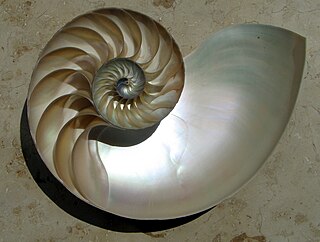 W
WIn mathematics, a spiral is a curve which emanates from a point, moving farther away as it revolves around the point.
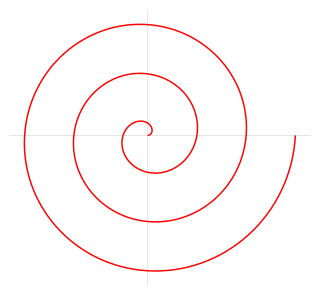 W
WThe Archimedean spiral is a spiral named after the 3rd-century BC Greek mathematician Archimedes. It is the locus corresponding to the locations over time of a point moving away from a fixed point with a constant speed along a line that rotates with constant angular velocity. Equivalently, in polar coordinates (r, θ) it can be described by the equation
 W
WIn mathematics, a conchospiral a specific type of three-dimensional spiral on the surface of a cone, whose floor projection is a logarithmic spiral.
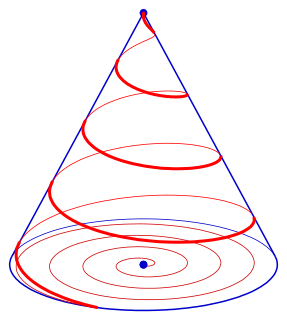 W
WIn mathematics, a conical spiral is a curve on a right circular cone, whose floor plan is a plane spiral. If the floor plan is a logarithmic spiral, it is called conchospiral.
 W
WIn physics and in the mathematics of plane curves, Cotes's spiral is a family of spirals named after Roger Cotes.
 W
WIn the mathematics of circle packing, a Doyle spiral is a pattern of non-crossing circles in the plane, each tangent to six others. The sequences of circles linked to each other through opposite points of tangency lie on logarithmic spirals having, in general, three different shapes of spirals.
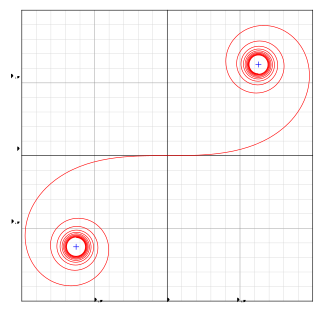 W
WAn Euler spiral is a curve whose curvature changes linearly with its curve length. Euler spirals are also commonly referred to as spiros, clothoids, or Cornu spirals.
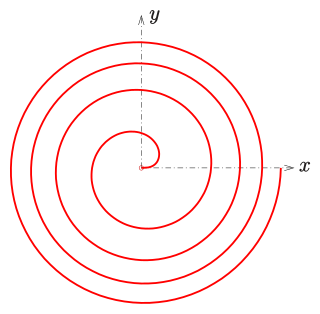 W
WA Fermat's spiral or parabolic spiral is a plane curve named after Pierre de Fermat. Its polar coordinate representation is given by
 W
WThe Fresnel integrals S(x) and C(x) are two transcendental functions named after Augustin-Jean Fresnel that are used in optics and are closely related to the error function. They arise in the description of near-field Fresnel diffraction phenomena and are defined through the following integral representations:
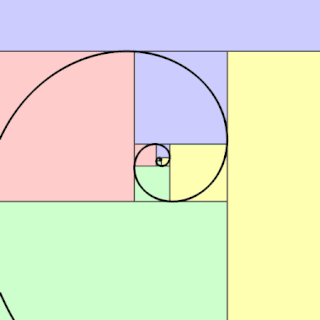 W
WIn geometry, a golden spiral is a logarithmic spiral whose growth factor is φ, the golden ratio. That is, a golden spiral gets wider by a factor of φ for every quarter turn it makes.
 W
WThe heliospheric current sheet is the surface in the Solar System where the polarity of the Sun's magnetic field changes from north to south. This field extends throughout the Sun's equatorial plane in the heliosphere. The shape of the current sheet results from the influence of the Sun's rotating magnetic field on the plasma in the interplanetary medium. A small electrical current flows within the sheet, about 10−10 A/m2. The thickness of the current sheet is about 10,000 km near the orbit of the Earth.
 W
WA hyperbolic spiral is a plane curve, which can be described in polar coordinates by the equation
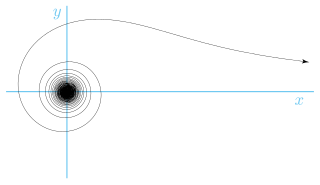 W
WIn mathematics, a lituus is a spiral with polar equation
 W
WA logarithmic spiral, equiangular spiral, or growth spiral is a self-similar spiral curve that often appears in nature. The logarithmic spiral was first described by Descartes and later extensively investigated by Jacob Bernoulli, who called it Spira mirabilis, "the marvelous spiral".
 W
WIn mathematics the Padovan cuboid spiral is the spiral created by joining the diagonals of faces of successive cuboids added to a unit cube. The cuboids are added sequentially so that the resulting cuboid has dimensions that are successive Padovan numbers.
 W
WIn navigation, a rhumb line, rhumb, or loxodrome is an arc crossing all meridians of longitude at the same angle, that is, a path with constant bearing as measured relative to true or magnetic north.
 W
WThis article discusses the geometric figure; for the science-fiction character see Spidron (character).
 W
WA spiral is a technique employed by railways to ascend steep hills.
 W
WSpiral galaxies form a class of galaxy originally described by Edwin Hubble in his 1936 work The Realm of the Nebulae and, as such, form part of the Hubble sequence. Most spiral galaxies consist of a flat, rotating disk containing stars, gas and dust, and a central concentration of stars known as the bulge. These are often surrounded by a much fainter halo of stars, many of which reside in globular clusters.
 W
WIn geometry, a spirangle is a figure related to a spiral. Spirangles are similar to spirals in that they expand from a center point as they grow larger, but they are made out of straight line segments, instead of curves. Spirangle vectographs are used in vision therapy to promote stereopsis and help resolve problems with hand–eye coordination.
 W
WIn geometry, the spiral of Theodorus is a spiral composed of right triangles, placed edge-to-edge. It was named after Theodorus of Cyrene.
 W
WA track transition curve, or spiral easement, is a mathematically-calculated curve on a section of highway, or railroad track, in which a straight section changes into a curve. It is designed to prevent sudden changes in lateral acceleration. In plane, the start of the transition of the horizontal curve is at infinite radius, and at the end of the transition, it has the same radius as the curve itself and so forms a very broad spiral. At the same time, in the vertical plane, the outside of the curve is gradually raised until the correct degree of bank is reached.
 W
WA track transition curve, or spiral easement, is a mathematically-calculated curve on a section of highway, or railroad track, in which a straight section changes into a curve. It is designed to prevent sudden changes in lateral acceleration. In plane, the start of the transition of the horizontal curve is at infinite radius, and at the end of the transition, it has the same radius as the curve itself and so forms a very broad spiral. At the same time, in the vertical plane, the outside of the curve is gradually raised until the correct degree of bank is reached.
 W
WAn Euler spiral is a curve whose curvature changes linearly with its curve length. Euler spirals are also commonly referred to as spiros, clothoids, or Cornu spirals.
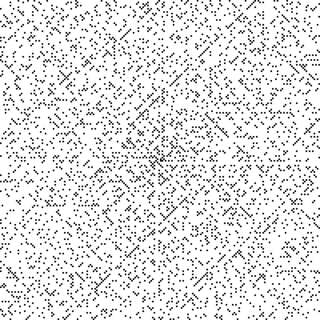 W
WThe Ulam spiral or prime spiral is a graphical depiction of the set of prime numbers, devised by mathematician Stanisław Ulam in 1963 and popularized in Martin Gardner's Mathematical Games column in Scientific American a short time later. It is constructed by writing the positive integers in a square spiral and specially marking the prime numbers.
 W
WUzumaki is a seinen horror manga series written and illustrated by Junji Ito. Appearing as a serial in the weekly manga magazine Big Comic Spirits from 1998 to 1999, the chapters were compiled into three bound volumes by Shogakukan and published from August 1998 to September 1999. In March 2000, Shogakukan released an omnibus edition, followed by a second omnibus version in August 2010. In North America, Viz Media serialized an English-language translation of the series in its monthly magazine Pulp from February 2001 to August 2002. Viz Media then published the volumes from October 2001 to October 2002, with a re-release from October 2007 to February 2008, and published a hardcover omnibus edition in October 2013.
 W
WThe Voderberg tiling is a mathematical spiral tiling, invented in 1936 by mathematician Heinz Voderberg. It is a monohedral tiling, meaning that it consists of only one shape, tessellated with congruent copies of itself. In this case, the prototile is an elongated irregular nonagon, or nine-sided figure. Because it has no translational symmetries, the Voderberg tiling is technically non-periodic, even though it exhibits an obvious repeating pattern.